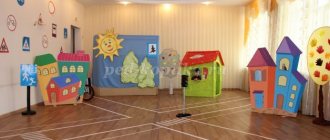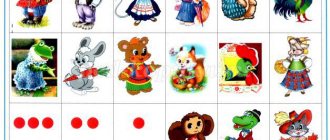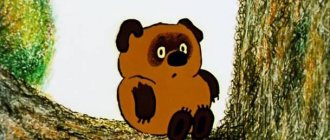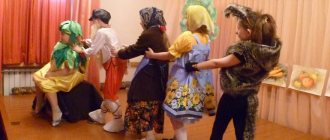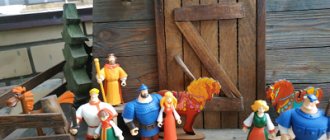Dramatization of a Russian folk tale in the preparatory group
Dramatization of the Russian folk tale “Zayushkina’s Hut.” Preparatory group
Goal: To teach how to dramatize the Russian folk tale “Zayushkina’s Hut.” Creating conditions for the child to develop an interest in theatrical activities and a desire to perform with a group of peers. Introduce the basics of acting. Learn to portray the emotional state of a character using expressive movements and intonation. Introduce tempo and rhythm. Learn clearly, pronounce words and sentences with different intonations (question, request, surprise, sadness, fear, etc.). Develop plastic movement, speech, logical thinking, imagination. Cultivate interest in theatrical activities. Objectives : To arouse interest in theatrical and play activities, to create a sense of success for each individual child; continue to introduce theatrical terminology (actor, director), drama theater to improve the ability to tell a fairy tale by role; teach intonation to convey the mood of the hero; cultivate a sense of empathy, sympathy; introduce “fairytale” vocabulary into children’s active vocabulary (bast, carrying a scythe, sitting on the stove). Material: Model of ice and bast huts, child-sized trees, bushes;
costumes (fox, hare, rooster, bear, dog, wolf); stump, sun, cloud. Progress of the dramatization game
Host: Dear guests! Watch and listen to the fairy tale “Zayushkina’s Hut.” Once upon a time there lived a Fox and a Hare. The Fox had an ice hut, and the Hare had a bast hut. The beauty of spring has arrived. Under the warm rays of the spring sun, the Fox's hut has melted, and the Hare's hut stands as if nothing had happened. So the Fox ran to the neighbor Fox: Bunny neighbor, let me warm up. Let me go, dear! Hare: Come in, Fox. Presenter: Before the Fox had time to enter the hut, she immediately began to chase the poor Hare. Fox: Go away, Oblique! So that your spirit is gone! Presenter: The Fox chased the Hare. He sat down on a tree stump and cried. Walks past the Dog: “Aw-aw-aw! What are you crying about, Hare? Hare: How can I not cry? I had a bast hut, and the fox had an ice hut. Spring has come, her hut has melted. She asked me to warm up and kicked me out. Dog: Don't cry, Hare. I'll kick her out! Presenter: The Dog went to the hut and began to chase the Fox. Dog. Aw-aw-aw! Go away, Fox. Aw-aw-aw! Fox: As soon as I jump out, as soon as I jump out, scraps will go down the back streets! Presenter: The Dog got scared and ran away into the forest. And the Hare still sits on the stump and cries. A wolf walks past. Wolf:What are you crying about, Hare? Hare: How can I not cry? I had a bast hut, and the fox had an ice hut. Spring came, her hut melted - she asked me to warm up and kicked me out. Wolf: Don't cry, Zainka. I'll kick her out! Hare: No, you won’t kick me out. The dog chased him, but he didn’t drive him out, and you, Wolf, won’t drive him out. Wolf: No, I'll kick you out! Presenter: The Wolf approached the hut and began to chase the Fox. Wolf: Come on, Fox, get out! Presenter: And Fox Wolf was a little scared. Fox: As soon as I jump out, as soon as I jump, scraps will go down the back streets. Presenter: The Wolf got scared and... ran away. Bear walks past the Hare. Bear: What are you crying about, Hare? Hare: How can I not cry? I had a bast hut, and Lisa had an ice hut. Spring came, and the Fox’s hut melted. She asked me to warm up and kicked me out. Bear: Don't cry, Bunny, I'll kick her out! Hare: No, Bear, you won’t kick him out. The dog chased but didn’t drive him out, the Wolf chased him but didn’t drive him out, and you, Bear, won’t drive him out. Bear: No, you-go-nu! Presenter: The Bear approached the hut and began to chase the Fox. Bear: Get out, Fox! Immediately! Host: But Lisa was not afraid. Fox: As soon as I jump out, as soon as I jump, scraps will go down the back streets. Presenter: The Bear got scared and ran away. The Rooster walks past the Hare. Rooster: Ku-ka-re-ku! Why are you crying, Bunny? Hare: How can I not cry? I had a bast hut, and Lisa had an ice hut. Spring came, and the Fox’s hut melted. She asked me to warm up and kicked me out. Rooster: I'll kick her out now! Hare: No. You won't kick me out. The dog chased but didn’t drive him out, the Wolf chased but didn’t drive him out. The bear drove him away, but he didn’t drive him out, and you, Cockerel, won’t drive him out. Rooster: No, I'll kick you out! I am a brave Rooster! Ku-ka-re-ku! Presenter: The Rooster approached the hut and began to chase the Fox. Rooster: Ku-ka-re-ku! I carry the scythe on my shoulders, I want to whip the Fox! Get out, Lisa. Fox: I’m putting on a fur coat... Rooster: Ku-ka-re-ku! I carry the scythe on my shoulders, I want to whip the Fox! Go, Fox Leader: The fox got scared and ran away. And the Hare and the Rooster began to live in Zaika’s hut. That's the end of the fairy tale!
We recommend watching:
Master Class. DIY shadow theater
Photo report from the fairy tale “The Scarlet Flower” Synopsis of a theatrical lesson in the second junior group Synopsis of a joint theatrical activity in a preparatory group on Russian folk tales
Similar articles:
The fairy tale “At the behest of the pike” in a new way. Role-based script for older preschoolers
Project on theatrical activities in accordance with the Federal State Educational Standard
Based on the provisions established by the Federal State Educational Standard for preschool education, approved in 2013 by order of the Ministry of Education and Science of the Russian Federation, the educational program should promote not only artistic, aesthetic and communicative advancement, but also contribute to the formation of cognitive interest, speech and physical development.
Preschoolers in kindergartens have the opportunity to participate in the types of theatrical activities presented below.
Stand theater
This art is the acting out of various scenes with the help of figures and decorations on a certain surface. The most common options are fabric stretched over a stand board, paper and fabric figures necessary for the plot are attached to it, and they move as the plot develops; arrangement of decorations on a magnetic board; a game of shadows, for which a lantern or lamp is pointed at a stretched white fabric, thereby illuminating black figures or hands, if “living shadows” are practiced.
Shadow theater in kindergarten
Theater on the table
The scenery and characters are made of paper (cardboard), natural materials (pine cones, autumn leaves, etc.), magnetic figures of the characters are also used - all of them are placed on the table on which the actions take place.
Finger Theater
In this type of theatrical activity, the main characters of the plots are presented in the form of dolls that are put on the hands, and each finger can represent a separate character. The preparatory group may be interested in the process of creating such dolls, so it is preferable to make them yourself from fabrics, cardboard, plastic objects and other scrap materials.
Didactic games for the younger group of kindergarten
Horse Theater
It involves the use of dolls placed above human height. Usually they are fixed on long boards. Also on horseback can be a finger theater, which is located high above the stage and in which the puppeteers are blocked by a dense screen.
Theater on the floor
The main principle of this theatrical performance is that the scenes are shown low above the floor, for which puppets are used. Since managing them requires more than a child’s dexterity and attentiveness, children should be involved in preparing the scenery and costumes for the dolls, and the performance itself should be conducted by the teacher.
Living Puppet Theater
It is understood that the heroes of the productions are the children themselves, and not the dolls controlled by them. Kids put on masks, as well as character costumes sewn onto aprons, conveying the movements of the characters with their bodies. “Live” dolls are often used at matinees and in speech development exercises. At concerts dedicated to national holidays, kindergartens stage fully costumed performances, preparation for which can take several months.
Living Puppet Theater
There are many original projects on the Internet containing sets of exercises and games with scenarios and a breakdown by time of their implementation. When planning the theatricalization process, you can combine existing techniques, choosing the most suitable productions for individual groups.
Game summary – dramatization “Telephone”
Bunnies. Can you send me some gloves?
Educator. (to children)
Shall we send it?
All. We'll send it!\And then the monkeys called. (Looks questioningly at the children, as if asking: what else might be needed?)
Monkeys. Please send me books!
Educator. (to children)
Shall we send it?
All. We'll send it!
A bear approaches the fairy phone and dials the number. The host's bell rings again.
Educator. And then the bear called. Yes, how he began, how he began to roar!
(The teacher encourages the bear to roar with gestures, when he growls, he continues)
Wait, bear, don’t roar
(The teacher spreads his hands helplessly, evoking sympathy from the children.),
Explain what you want?
(The bear continues to roar.)
Educator. But he only “M-u” and “M-u”, and why the hell - I don’t understand!
Everything (very strictly).
Please hang up!
Educator. And then the crocodile called and asked with tears ... (The teacher shows a picture of galoshes, and the crocodile, as best he can, asks to send him galoshes.)
Educator. Listen, children. (The teacher passes the phone to one of the children)
Crocodile. My dear, good one, send me galoshes for me, my wife, and Totosha.
Educator. (Surprised)
Wait, wasn’t it you who I sent two pairs of excellent galoshes last week?
Crocodile. Oh, we ate the ones you sent last week long ago and can’t wait for you to send a dozen for our dinner again
new and sweet galoshes!
(The teacher and the children are surprised at the crocodile’s gluttony, but still give him a bunch of galoshes. The phone rings again.)
Educator. Bear again...What? Save the walrus?! (The teacher looks at the children in surprise)
Yesterday he swallowed a sea urchin......!
(The phone rings.)
Educator. And yesterday morning Kangaroo... Listen, children! (The teacher hands the phone to the children)
Kangaroo. Isn't this the Moidodyr apartment?
Educator. (Teacher angrily)
No! This is someone else's apartment!!!
Kangaroo. Where is Moidodyr?
Educator. I can’t tell you... Call number one hundred twenty-five.
And such rubbish all day long...
All. Ding-di-lazy, ding-di-lazy, ding-di-lazy, then the seal will call, then the deer.
Educator. And recently two gazelles called and started singing...
Gazelles. Did all the carousels really burn down?
All. Oh, are you sane, gazelles? The carousels did not burn down, and the swings survived! You gazelles wouldn't make a noise, but next week you'd gallop up and sit on the swing-carousel!
Educator. But they didn’t listen to the gazelles and continued to make noise...
Gazelles. Are all the swings really on fire?
All. What stupid gazelles!
Educator. I didn't sleep for three nights. I'm tired. I would like to fall asleep, relax... But as soon as I lay down, the bell rang! (A telephone rings.)
Who's speaking? Rhinoceros?
My kindergarten
Goal: To teach children to emotionally and actively perceive a fairy tale, to participate in a dramatization game. Objectives: Learn to understand the meaning of riddles. (H.L.) Make children want to use words and expressions from the fairy tale. To develop the ability to correctly use tempo, volume (intonation) of speech, and clearly pronounce sounds, words, and phrases. (TO). To promote the development of skills in expressive and emotional transmission of playful and fairy-tale images: a bear is walking, little mice are running, a bunny is jumping. (M) promote the development of cognitive, creative activity, logical thinking, attention in children; identify the creative talent of students; bring children joy and pleasure from dramatizing a fairy tale. Foster a sense of teamwork and friendship.
Material: mouse, frog, bunny, fox, wolf, bear hats. House-teremok. Music for every hero.
Preliminary work: Storytelling by R.N.S. “Teremok”, examination of illustrations for the fairy tale, d/i “Who is screaming?”
Progress of the lesson
I Organizational moment V-l. Look how many guests we have. Say hello to them! Greeting: all the children gathered in a circle. I am your friend and you are my friend. Let's hold hands together and smile at each other. Hello, golden sun! Hello, blue sky! Hello my friends! I'm glad to see you all! asks a riddle: There is a painted house, It is so beautiful. The animals walked across the field, They stayed in the house to live. They lived together, did not grieve, and lit the stove in the house. The bear destroyed the house and almost crushed his friends. -What fairy tale are we talking about? Topic message – Today we will play with the fairy tale “Teremok”. Here is a magic chest: “I’ll make a riddle, guys, try to guess them, if the answer is correct, the fairy tale will come to us again.” Main part: Stage I
- If there is a fire in the house, it will get to the food. Sugar, cheese and crust - Everything will be dragged down the hole!
Gray baby. Who is this? ( Mouse ) (I take out the mouse’s cap) - How does the mouse squeak? -Who will be the little mouse? What voice does the mouse speak in? (subtle)
2. Jumps on land and swims on water. (frog) How does a frog croak? -Who will be the frog? What voice does the frog speak in? 3 . He loves to gnaw carrots, He eats cabbage very deftly, He gallops here and there, Through the fields and through the forests, Gray, white and oblique, Who, tell me, is he? ( Hare ) - Who will be the running bunny? How does our bunny jump? 4. The prickly impatiens live in the thicket of the forest; there are a lot of needles, but not a single thread? (hedgehog) - How does a hedgehog snort? Who will be the hedgehog? 5. The cunning and dexterous red-haired cheat got into the barn and counted the chickens. (fox) How does the fox walk? – Who will be the little fox-sister? What voice does the fox speak in? 6. Who walks around angry and hungry in the cold winter. (wolf) - Who will be the gray barrel top? What kind of voice does the wolf speak in? (fat) 7. In winter he sleeps in summer, he stirs up the hive. (Bear) Who will be the clumsy bear? What voice does the bear speak in? (Draw the children’s attention to the intonation of speech) The children are given animal hats.
Physical education minute:
Stage II A dramatization game is carried out. V-l with the children stand in a circle. The center of the circle is the tower. V-l with the children walk in a circle, while saying the words: “There is a teremok-teremok in the field. He is not short, not high, not tall. Here a mouse (frog, bunny, fox, wolf, bear) runs across the field, stops at the gate, says...” All the heroes, in turn, go out into the middle of the circle with the words: “Knock, knock, who lives in the little house...” Vospt. : The animals began to live together, They began to live and not bother. They live together, have fun, and sing a song about friendship. There is a mansion in the field, a mansion, It is very, very tall. You can’t live here without fun, Friends live in the mansion! We all sing the song “Smile” together. Result: – What fairy tale came to visit us today? – You liked playing and showing the fairy tale. Let's be as friendly and kind as the mouse, frog, bunny, fox, wolf and bear in the fairy tale "Teremok".
Author: Yudakina Valentina Viktorovna , teacher, Municipal budgetary preschool educational institution Kindergarten N3 “Bell”, Nizhny Novgorod region, village of Diveevo.
